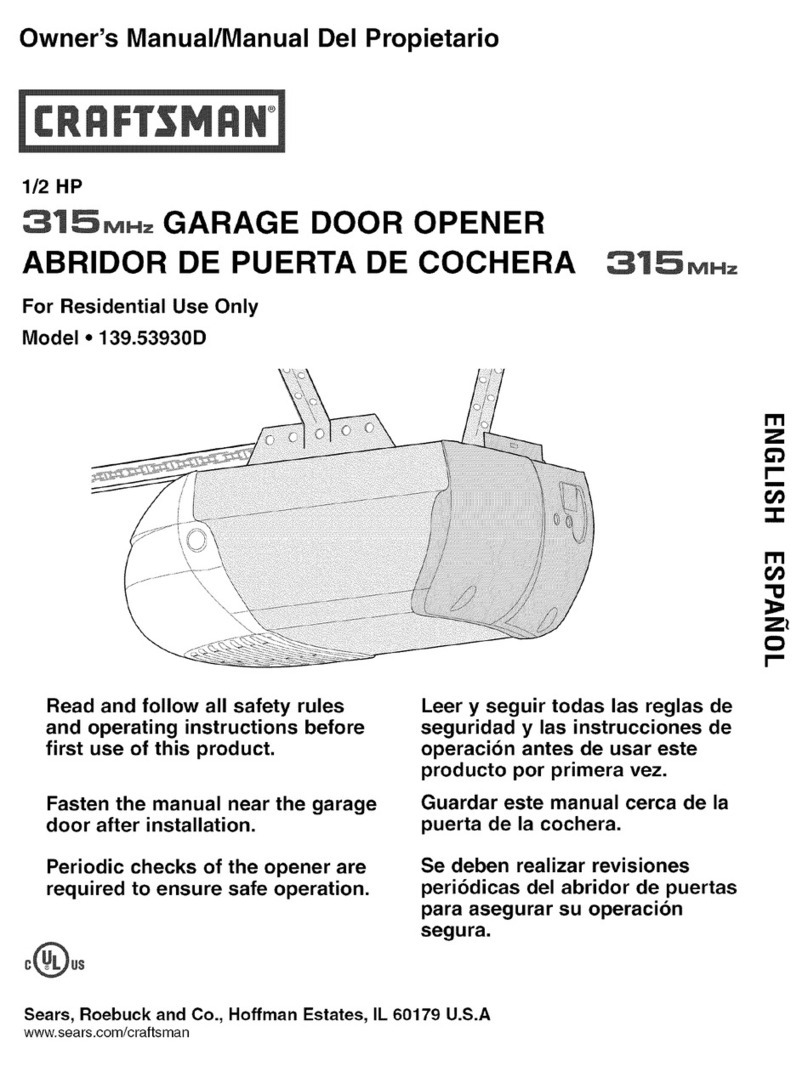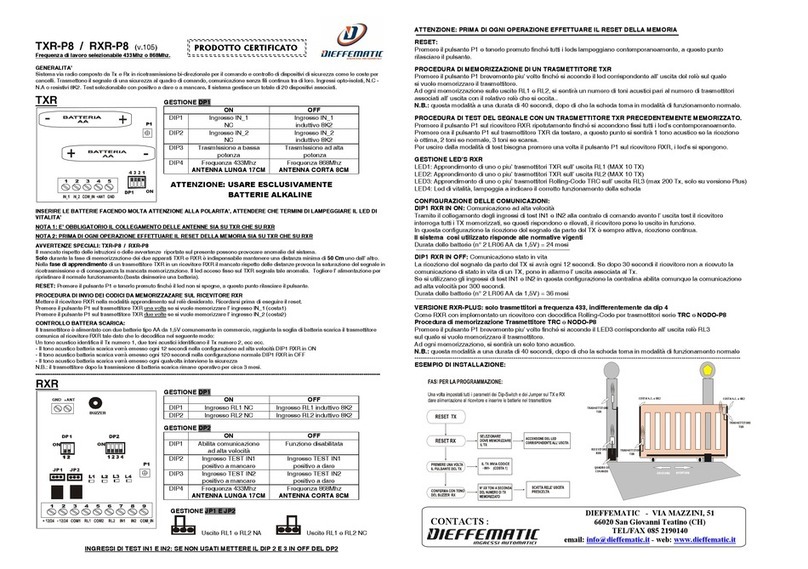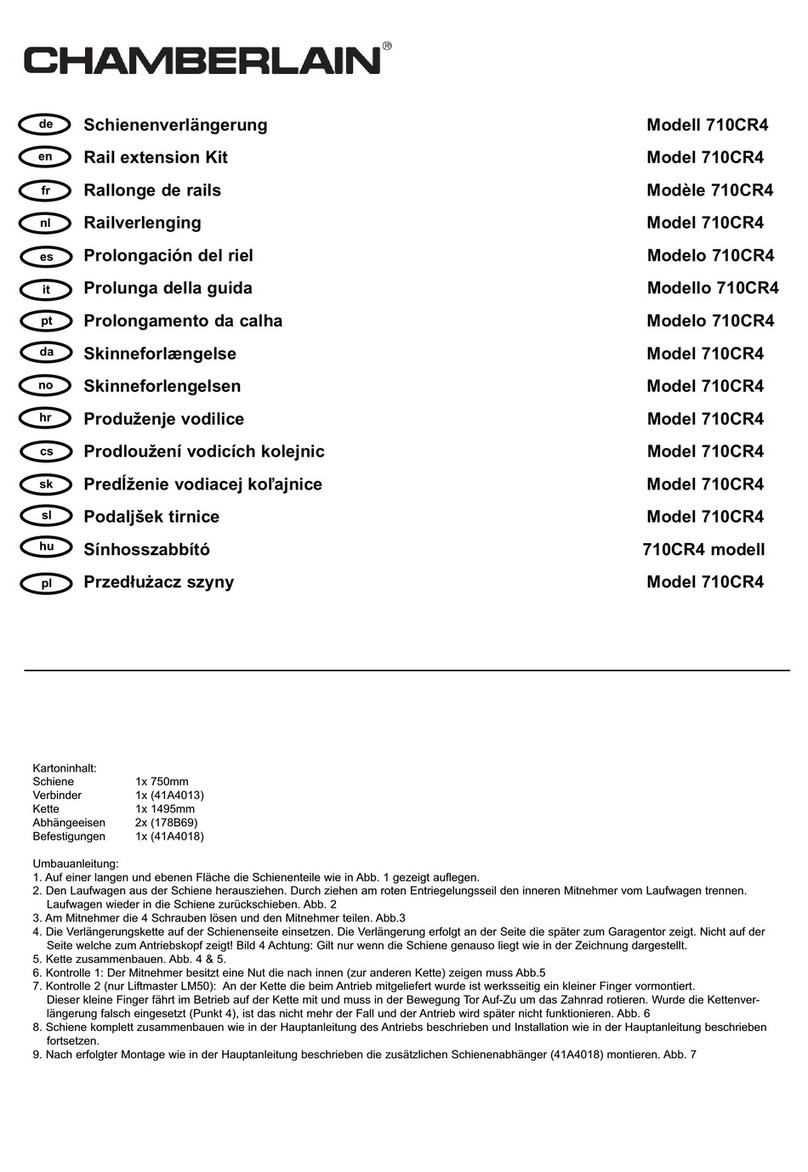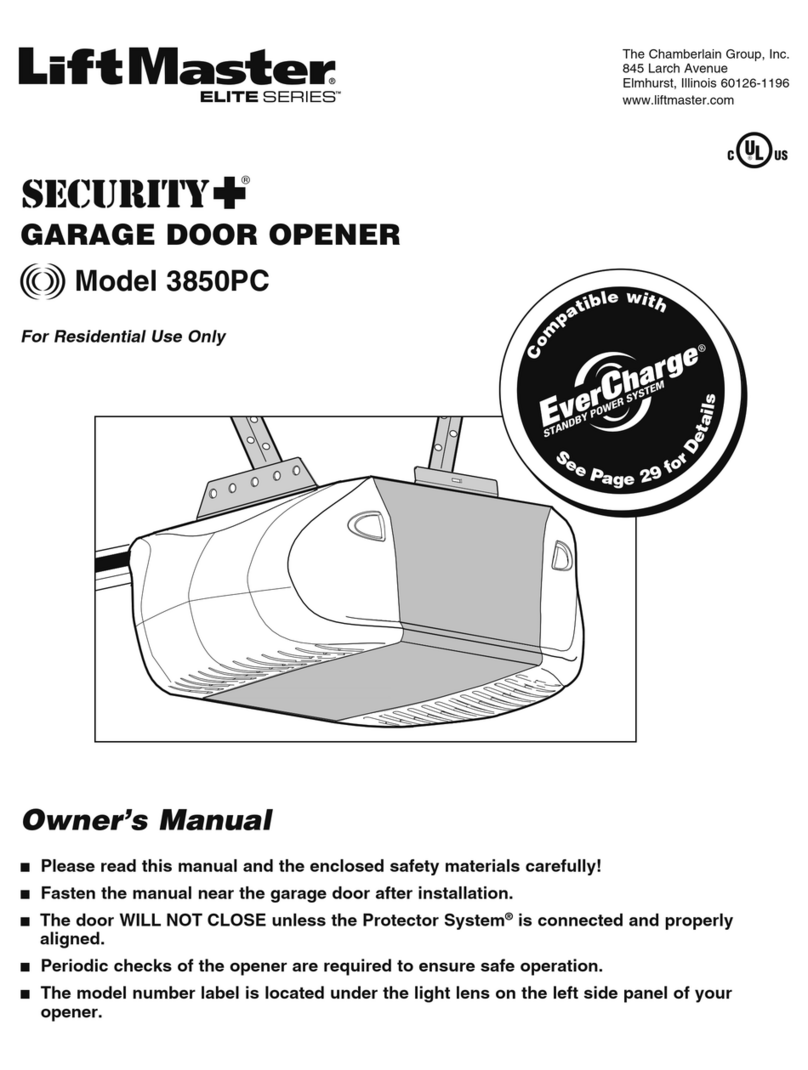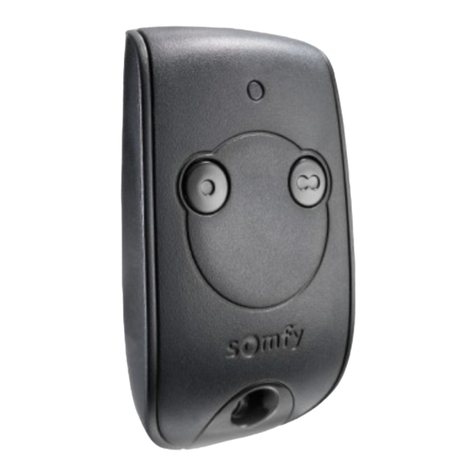Digidoor Paratrak User manual

A Unique Concept in Roll-up Door Automation
Intended Use
The Paratrak is intended for the automation of the Digi Roll-up Door,
and may be adapted to other makes of roll-up doors by means of
Adapter Kits. Typically, a roll-up door weighs about 30 kg.
The width of a roll-up door may vary from 2,44 m to 3 m, and the height
from 2,135m to 3 m.
Longer Drive Shafts and Chain Kits are available for wider and/or
higher doors.
If needed, (e.g. to avoid a tow-bar on a vehicle in a short garage) the
Paratrak may be mounted off-centre. This is possible, and the longer
Drive Shafts are required.
Paratrak Installation Instructions on Digi Roll-up Doors
Preparation
Prior to automating the roll-up door, inspect the door with a view to
ensuring satisfactory manual operation; it is a mistake to imagine that
automation will overcome the faults of a mal-functioning door.
The operator will interpret excessive resistance to door movement,
due to poor alignment, balance, snagging or excessive wear and
tear of working surfaces as an obstacle thereby preventing reliable
movement of the door. Eliminate all hindrances to free and smooth
door operation.
Check that the side-guides are free of grease, dirt and dents; and are
secure, vertical and straight.
Check that the triangular support brackets are secure and level. The
springs inside the door roll should have a light coating of grease.
The door should operate smoothly and easily using one hand, and
remain stationary when left at any point of travel. Adjust the spring
force if necessary (refer to the door installation instructions).
Remove or disable any unnecessary equipment or fi ttings, not needed
for automated operation. If fi tted, leave the centre lock un-locked.
WARNING!
Important Safety Instructions. Follow all instructions carefully, as
incorrect installation could lead to severe injury. It is important for the
safety of persons to follow all instructions. Save these instructions for
future reference.
•Do not allow children to play with door controls
•Automated doors should only be operated whilst in full view
•Take care when operating the manual release since an open door
may fall rapidly due to weak or broken springs, or mal-adjustment
•Frequently examine the installation for signs of wear or damage,
in particular, that tracks and mountings are secure, and that the
balance of the springs is correctly adjusted
•For use of the manual release, refer to the section Manual Operation
on page 11
•During maintenance or adjustment, disconnect the mains supply
•This appliance is not intended for use by persons (including
children) with reduced physical, sensory or mental capabilities, or
lack of experience and knowledge, unless they have been given
supervision or instruction concerning use of the appliance by a
person responsible for their safety.
Permanently fi x labels warning against entrapment in a prominent
place or near any fi xed controls.
After installation, ensure that the mechanism is properly adjusted and
reverses when closing upon an obstacle, 40mm high, placed on the
fl oor.
The drive must not be used on a roll-up door incorporating a wicket
door (unless the roll-up door cannot be operated if the wicket door is
closed).
After installation, ensure that parts of the door do not extend over
public foot paths or roads.
Contents of the Package
The Paratrak Operator consists of a carton and a set of two shafts,
which may be chosen for standard or special door widths.
The carton contains:
Recommended Tools and Equipment for this installation
• An Instruction pamphlet
•The Paratrak Drive Unit
•Battery Box assembly,
with a Controller and two
12V Batteries
•Hardware Pack with nuts and bolts
•24V Power Adapter
•Two Sprocket assemblies
•Four Bearing Brackets
• Grease Sachet
• Junction Box
• Curly Cable
• Two lengths of roller-chain
• eKey Remote
• Battery cable with plug
• White Jumper wire
• 500 mm of twin-fl ex
• Electric Drill (with hammer action)
• Drill Bits
Masonry: 5.5 mm, 8 mm
Steel: 3.5 mm, 4 mm, 6 mm, 7 mm
• Tape Measure – 5 m
• Hammer
• Hacksaw
• File
• Allen Key 3 mm
• Screwdriver
6mm (Philips/Pozi)
• Spanners
Sockets: 10 mm
Flat /Ring: 7 mm
• Spirit Level
• Step Ladder – 1,7 to 2 m high
• Extension Lead to suit
– INSTALLATION –
It is assumed that the proper condition and
balance of the door has been achieved.
Step 1
Inserting the chains into the Sprocket Covers, left and right
Insert the fi rst link (the one without
the anchor pin) of one of the chain
bundles into the opening of the
shorter side of a Sprocket Cover
assembly. Push the chain through,
link-by-link, until it emerges at the
other side. Pull the chain about
halfway through the assembly.
Repeat for the other chain bundle
and Sprocket Cover assembly. See
Figure 1.
Step 2
Fixing the Chain Anchor to the floor, left and right
Starting on the left side, mark out the drilling dimensions as in Figure 2.
Using a Ø8 mm masonry bit, drill each hole as indicated to a depth of at
least 65 mm, and fi t two Ø8 x63 Screw Plugs. Please refer to the following
tips. Note: the box has a drilling template for ease of use.
TIPS
1. Accuracy is important! Before drilling, extend the centre-lines well
beyond the hole-positions.
2. Start each hole with the drill set to normal (no hammer) and, while
focusing on accuracy, drill initially to a depth of about 5mm before
changing the drill to hammer.
3. To avoid snapping screws inserted in the fl oor; after drilling each hole,
leave the mounds of dust. Insert the tips of the screw-plugs part-way
into the holes, and then brush away the mounds of dust. Drive the
plugs in fl ush. Apply a lick of grease to the bolt threads before fi tting.
Figure 1
Figure 2 Left Side. Mirror for the Right side.
Step 6
Connecting the Cables
Flex the side clips and remove the Light Cover from the front of the Battery
Box. Set the cover aside until later.
Place the two batteries in the Battery Box with the terminals of each near
the middle.
As in Figure 8, connect the Black battery wire to the left Black terminal,
and the Red battery wire to the right Red terminal. Leave the 3-Pin plug
from the batteries un-plugged at this stage. Connect the White Jumper
wire from the left Red terminal to the right Black terminal. Insert the
matching plugs from the Paratrak into the sockets, fi rst and fourth from
the right of the Controller. See Figure 9.
At this stage, check that the door is neutrally balanced. If necessary, adjust
the spring force to balance the door.
Step 7
Cutting the Shafts to length
Starting on the left side, move the Sprocket Cover assembly to the same
level as the bottom rail. Note the size of the gap between the Sprocket
Cover and the side guide (see Figure 10). Insert the formed end of a Shaft
into the hub of the sprocket inside the Sprocket Cover Assembly and,
while maintaining the gap, hold the Shaft horizontally so that it overlaps
the hub of the Paratrak, and mark the Shaft opposite the centre of the
nearest hub screw (see Figure 11).
Cut the Shaf t at that mark and de -burr the shar p edg e with a fi le. Slide two
Bearing Brackets onto the shaft, clip them into the bottom rail (as in Figure
12) and push the end of the shaft into the Output Shaft.
Figure 3
Step 3
Securing the Chain to the triangular support bracket
Again, starting on the left side, mark the drilling position on the upper
fl ange of the triangular support bracket as in Figure 4. Centre-punch and
drill a Ø4.5 mm hole.
Refer to Figure 5. Near the top end of the chain, choose a chain link such
that, when an M4 Socket Head Cap Screw is pushed through that link and
through the Ø4.5 mm hole in the triangular support bracket, a washer and
an M4 Nylok Nut can be fi tted, leaving suffi cient thread on the bolt so that
the chain may be tensioned. For now, take up the slack. Repeat for the
right side.
Step 4
Mounting the Paratrak and the Battery Box
With the foot of the door
opened to waist height,
measure and mark the
horizontal mid-point of the
door just above the bottom
rail. Position the Paratrak unit
with its output stage centred
on the mid-point of the door,
and its underside touching
the aluminium bottom rail.
Drill through the upper-right
mounting bush with a Ø6 mm
bit.
Reach under the bottom rail
and push an M6 Cup Square
Bolt through the hole and the
mounting bush, and fi t an M6 nut, fi nger-tight. Now, with the Ø6 mm bit,
drill through the remaining three mounting bushes. Remove the unit from
the door and enlarge all the holes with a Ø7 mm bit. Refi t the unit using
four M6 Cup Square Bolts and M6 Nuts, tightening them with a 10mm
socket nut-driver until the heads are fl ush on the outside.
Step 5
Battery Box
Hold the Battery Box (without
batteries) against the door
to the left of the Paratrak
with its feet standing on the
bottom rail, with a 30 mm gap
between the two.
In this position and on the
right of the box, drill through
the mounting bush that best
suits the corrugation of the
door with a Ø6 mm bit. As
above, fi t an M6 Cup Square Bolt and nut, fi nger-tight. Drill through the
corresponding mounting bush on the left. Remove the Box and enlarge
the holes with a Ø7 mm bit. Secure the Box with two M6 Cup Square Bolts
and nuts, tightening them with a 10 mm socket nut-driver until the heads
are fl ush on the outside.
Figure 4 Figure 5
Figure 6
Figure 7
Figure 8
Figure 9
Figure 10 Fig u re 11
The Paratrak drives the door symmetrically by
means of chains and sprockets, applying the
force symmetrically to both ends of the bottom
rail, ensuring smooth and even operation.
Optional receiver
terminals
Controller
socket
Curly cord
socket
Battery
plug
Motor
socket
plug
Auto close link Button Force adjustment Beam link
Auto close link
Button
Force adjustment
Beam link
Force adjustment
A video is
available on our
website to assist
you with this
installation.
As in Figure 3, engage the pin at the end of the chain in the ‘V’ of the Chain
Anchor. Ensuring that the chain is between the wall and the sprocket in the
cover, place the Chain Anchor over the screw plugs and fi t two Ø6 Coach
Bolts with Body Washers. At this stage, leave the bolts loose enough to
allow the Chain Anchor to move (‘Float’) freely. Repeat for the right side.
Figure 12
Sprocket housing
assembly
Chain
Outer bearing
bracket
Bottom
rail
Inner bearing
bracket
Left drive
shaft
Chain
Chain
Chain
bracket
bracket
rail
assembly
bracket
assembly
bracket
shaft
Front
Wall Doorway
Left Hand
Track
Dimension ‘B’
may vary from
18-22mm
40
‘B’
Dimension ‘A’ may
vary from 22-25mm ‘A’
Roll-up Door
Top V iew Triangular
Bracket
Ø4.5
23
48
Doorway
Front
Wall
Top Chain Fixing
and Tensioner
Chain
Left
Chain
Drive
Shaft
Sprocket
Housing
Chain Anchor
right side
Bearing Bracket
2 each side
Paratrak Unit
mounted to the door

S t e p 11
Set-up
Switch on the Power Pack at the 3-Pin Mains Socket.
Referring to Figure 9, plug the 3-Pin plug from the batteries into the
socket, second from the right on the Controller. The lights will fl ash and
the beeper will sound, and the LED on the Controller will fl ash orange. (If
the LED shows green, a ‘Reset’ is required; see Reset on page 11).
• Ensure that the Limit Slide is in the upper-most position. Refer to
Fig u re 17
• Move the Manual Over-ride Lever fully anti-clockwise
• Press the button on the Controller and the LED will show red
• By hand, move the door to the closed position against the fl oor
• Move the Manual Over-ride Lever fully clockwise
• Depress the Limit Slide Button and move the Limit Slide slowly
downwards, until the LED on the Controller changes from red to green.
Release the Limit Slide Button.
Keep clear during this phase.
Press the button on the
Controller (see Figure 9).
The Paratrak will slowly open
the door in ‘seek’ mode until
the fully open position is
reached. The Paratrack will
then close, stopping on the
fl oor.
The Controller will beep
twice and the LED will
double-fl ash orange.
St e p 12
Adding the eKey Remote
Press the bu t ton on the Controller and the LED will fl ash orange. Within 30
seconds, press the chosen button on the eKey Remote, causing the LED
to turn off. Press the same button on the eKey Remote again and the LED
will fl ash and the Beeper will sound four times. The eKey Remote is ready
to use. Note: For security reasons, adding remotes requires the door to
be fully closed.
For additional eKey Remotes, repeat Step 12.
Reset.
If, for any reason, the Set-up procedure above needs to be repeated, fi rst
reset as follows:
From the Controller, un-plug the Telecom plug (Curly cord) and the
Battery plug. Push and hold the button on the Controller while inserting
the Battery plug. The Lights will fl ash and the Beeper will sound and the
LED will fl ash orange. Continue Set-up (Step 11).
St e p 13
Adjusting Obstacle Sensing
Important (For safety reasons, perform this check twice a year.)
Referring to Figure 9, set the ‘FORCE’ adjuster mid-way. Using the eKey
Remote, open the door. Start the door closing and, while standing to the
left or right of the Paratrak, obstruct the door by hand. The door should
sense the obstruction and reverse. If the force seems too high or low,
make a slight change on the ‘FORCE’ adjuster (clock-wise for more), and
test again.
Step 8
Securing the Shaft to the Motor
Important! With the door open to slightly above waist level (for a
comfortable working height), check that the foot of the door is level.
Move the Manual Over-ride Lever anti-clockwise and turn the Output
Shaft by hand until the holes are horizontal, as in Figure 13. Re-engage
the motor by moving the Manual Over-ride Lever clockwise to lock the
Output Shaft in place.
Important! Check that the gap between the Sprocket Cover and the
side guide is correct (Figure 10). Using a sharp Ø4 mm bit, carefully drill
through the hole in the Output Shaft with attention being paid to keeping
central, level and square. Push an M4x20 Socket Head Cap Screw through
the hole just drilled.
Repeat ‘Cutting’ and ‘Securing the Shaft’ for the right side (Steps 7 and
8), remembering to slide the two Bearing Brackets onto the other Shaft.
Release the motor by means of
the Manual Over-ride Lever, lift
the door until the tips of the M4
screws come into view and fi t
M4 Nylok Nuts. Lower the door
until the Heads of the M4 screws
come into view. Tighten the M4
screws and nuts with a 7 mm
spanner and a 3 mm Allen key.
Step 9
Securing the Bearing Brackets
(For a Digi-Roll-up: If fi tted, remove the red Foot Stops from the bottom
Rail.)
On the left side, position the left edge of the Bearing Bracket fl ush with
the end of the aluminium Bottom Rail. Using a Ø3.5 mm bit, drill through
the mounting bushes in the Bearing Bracket and fi t two #8x25 mm Self
Tapping Screws. Likewise, mount the next Bearing Bracket 600 mm to the
right of the fi rst. Repeat the above for mounting the Bearing Brackets on
the right side. Snip a corner off of the grease sachet and apply grease to
the shafts where they are visible in each bracket, as well as the underside.
Tensioning the Chains
Release the motor by means of the Manual Over-ride Lever and, by hand,
close the door fully. Now tighten the Ø6 mm Coach Bolts in the Chain
Anchors, left and right.
Using a 3 mm Allen Key and a 7 mm spanner, tighten the M4 Nylok Nut
above the triangular support bracket, to tension the chains so that no
slack is evident and both chains feels fi rm. Refer to Figure 5.
Step 10
Mounting the Power Pack and Junction Box
Remove the dust-cover from the Junction Box. Depending on the position
of the nearest mains 3-pin power socket, choose a front or side wall. On
that wall, using the #4 screws and Ø5.5 mm plugs supplied, mount the
Junction Box as in Figure 14, 1.1 m from the fl oor and 100 mm from the side
guide of the door.
Take care to avoid damaging the wires in the Junction Box.
Plug the Power Pack into the 3-Pin Mains Socket; do not switch on yet. Use
the twin-fl ex cable to connect the Power Pack to the Junction Box as in
Figure 15, making use of the Yellow and Blue terminals, marked ‘AC 24V’.
(Note: depending on the position of the power point, a longer length of
twin-fl ex may be required). Secure the ca ble to the wall by means of cable-
saddles. Fit the dust-cover to the Junction Box. Plug the short end of the
curly cord into the Junction Box.
As in Figure 16, attach the beginning of the straight portion of the curly
cord to the tip of the nearest bearing
bracket with a cable-tie, then at the
diagonal attachment point. Plug the
free end of the curly cord into the
socket third from the right of the
Controller (Figure 9). Secure the cord
to the next bearing bracket with a
cable-tie. Finally, fold up any slack
cable and secure it with a cable-tie.
Trim the free ends of the cable-ties.
Measure the distance from the Key Release to the end of the Manual
Over-ride Lever in the horizontal position. Cut the cable 150 mm longer
than this distance. Insert the Key Release into the body and lock it. Loop
the cable around the end of the Manual Over-ride Lever and secure it with
an electrical screw clamp.
Manual Operation
To release the door from the Paratrak unit for manual operation, move the
yellow lever at the right end of the unit, from its horizontal position in an
anti-clockwise direction until it touches the body.
The door may now be moved by hand. To re-engage the drive, return the
yellow lever to the horizontal position in a clockwise direction. Note that
the door may be re-engaged in any position, and, if not closed, the next
operation will cause the door to close slowly until the fl oor is reached.
Fitting Safety Beams
Choose and mark a suitable mounting height on both sides of the gate
or doorway, low enough to protect toddlers and pets, but not lower than
the under-side of most motor vehicles. Mount the Safety Beam units
(Transmitter and Receiver) opposing one another, and at the chosen
height. Note: Do not screw or rivet through the side tracks. This will
interfere with the free movement of the curtain.
Wiring (Refer to Figure 15)
In the Junction Box (dust cover removed), use the White terminal to supply
positive(+) voltage to both beam units, and the black terminal to make the
negative (-) connection to both beam units. If a Digitronic Safety Beam
set is used, in the receiver unit, connect a short wire from negative (-)
to ‘COM’. Lastly, connect the Red terminal to the beam normally closed
(N.C.) terminal on the beam Receiver unit.
Set-up
Referring to Figure 9, enable the Safety Beam by removing the link below
the Telecom plug. The Safety Beam will not function if this is not done.
Interrupting the beam during closing will cause the Paratrak to stop and
reverse, but will be ignored during opening.
Enabling Auto-close
Warning! It is strongly advised that Safety Beams are fi tted before
making use of Auto-close.
Referring to Figure 9, remove the Auto-close Link to the right of the 3-way
screw terminals. For convenience, store the Link on a single pin. The
Auto-close timer will start after the door has stopped opening; after ten
seconds the beeper will sound and the lights will fl ash for a further ten
seconds before the door starts to close. Interrupting the safety beam will
reset the timer, and the timer will not start while the beam is interrupted.
Fitting a Wall Console
Fix the Wall Console to the wall, in a convenient position (usually next to
the side door) at a height of at least 1,5m, within sight of the automated
door, but clear of moving parts. To add the Wall Console to the Paratrak,
close the door and un-clip the cover from the Battery Box. As in ‘Adding
an eKey Remote’, press the button on the Controller and the LED will
fl ash. Within 30 seconds, press the large button on the Wall Console,
causing the LED on the Controller to turn off. Press the same button on
the Wall Console and the LED will fl ash and the Beeper will sound four
times. The Wall Console is ready for use. The large button will control the
Paratrak (Open, Close and Stop). The button with the light symbol turns
the Paratrak lighting on and off. (Note that this lighting will still go off after
three minutes). Normal operation of the Paratrak is locked and un-locked
by means of the button with the key symbol. The LED on the Controller
changes from green to red when locked.
Fitting an Additional Receiver
An additional receiver may be connected by means of the terminals shown
in fi gure 8. These are:
‘-’(0V), ‘+’(24V) and ‘▲▼ ’ (Operate, N.O. contact, active low signal). This
receiver should not exceed 50mA. The range of this receiver may be
degraded; if so, increase the mounting distance to at least 1 metre from
the Controller.
Status Indications
The single L.E.D. on the controller indicates the status of the Paratrak as
follows:
• Green (solid) - Ready, Mains is on
• Green (fl ashing) - Ready, Mains is off - battery voltage good
• Red (fl ashing) - Battery low – door cannot operate – restore mains
to charge
• Red (solid) - Door locked by means of the wall console – will
beep once when operation is attempted – unlock
using the wall console
• Orange (fl ashing) - Reset – Programming mode – see Step 11, Set-up
for details Page 9
Note: To save power, the Status L.E.D turns off when the Courtesy Light
times out.
– ADDITIONAL INFORMATION –
Erasing all eKey Remotes
Note: This procedure will erase all the eKey Remotes that have been
added to the Paratrak. Ensure that all the relevant eKey Remotes are
available, to re-add them after erasing. Referring to Figure 9, press and
hold the button on the Controller. After ten seconds the LED will fl ash
and the Beeper will sound four times. This indicates that all eKey Remotes
have been cleared from memory.
Fitting a Key Release
A Key Release is required where
there is no side door; the garage
door providing the only access.
Refer to Figure 18. In the second
externally recessed corrugation
above the Paratrak, mark a point
250 mm to the left of the Manual
Over-ride Lever, and 150 mm above.
Drill and mount the Key Release at
this mark.
Figure 18
WARRANTY
Hydro Doors and Gates (Pty) Ltd (Hydro) warrants to the fi rst retail
purchaser of a Digidoor Paratrak Operator that the product shall be
free of any defects in materials and/or workmanship for a period of
twelve months (One Year) from the verifi able date of purchase. Such
verifi cation will include a valid proof of purchase by the fi rst retail
purchaser, which shall include if possible the serial number of the
motor under warranty.
Upon receipt of the product, the fi rst retail purchaser is under
obligation to check the product for any visible defect. This warranty is
available on any Digidoor Operator sold and installed in the Republic
of South Africa. For any Digidoor Operator that is sold and installed
outside the borders of the Republic of South Africa, the obligations for
repairing this product under warranty will be borne by the distributor
of the product in the territory concerned. The terms and conditions of
warranties in each territory outside the Republic of South Africa will be
available from the distributor in that territory.
Conditions
The warranty shall constitute the sole remedy available under law to
the fi rst retail purchaser for any damages related to or resulting from
a defective part and/or product. The warranty is strictly limited to the
repair or replacement of the parts of this product which are found to
be defective.
The warranty does not cover:
• Non-defect damage caused by unreasonable use (including use
not in complete accordance with Digidoor installation and owners
instructions).
• Labour charges for removal or re-installation of a repaired or
replaced unit, transport costs incurred in getting the product to
Hydro. Hydro will quote for in-situ warranty repairs if requested.
• Damage to the product caused by lightning, power surges, or
incorrect installation.
• Any Hydro garage door operator used to automate more than one
door at one time.
• Any Hydro garage door operator used outdoors, including
carports.
• Any Hydro residential garage door operator used in excessive
traffi c applications for example: an apartment-block, parking
garage etc.
• Any unauthorised non-Hydro modifi cations to the product or
components thereof.
• Consequential or incidental damage to property or person.
• Batteries installed in the operator, remote controls or wall console.
Hydro will repair, or at its option replace, any device, which is
determined to be defective in materials and/or workmanship at no
cost to the owner for the repair and/or replacement part. Defective
parts will be repaired or replaced with new or factory rebuilt parts
at Hydro’s option. Hydro shall not be liable for consequential or
incidental damage to property or person. Warranty repairs shall
be effected, provided that the product is returned to Hydro at the
owner’s expense. No representative or person is authorized to assume
for Hydro any other liability in connection with the sale of this product.
Fi g u r e 17
Fi gure 14 Figure 15
Figure 16
Limit slide
Limit slide
Choose reliability,
choose quality, choose
www.hydrodoors.co.zaE-mail: [email protected].za
Patented Design: 2015/07462
®Registered Trademark © Digidoor 2017
Hydro Doors & Gates (Pty) Ltd.
8 Horsechestnut Avenue, Northlands Business Park,
Northriding, Gauteng, South Africa.
Tel: 011 888 6969
Supply Voltage 240V A.C. Max. motor
power 109 W
Mains Current 25 mA Motor Voltage 24 VDC
Power
consumption 5 W max Door speed 0.19 m /Se c
Max. Motor
Torqu e
2.8 kg.cm @
max. power
Max. Output
Torqu e
2.16 kg.m @max.
power
Batteries 12V 1.3Ah x 2
Battery Standby
(initially
fully-charged)
20+ Cycles after
8 hours without
mains power
Digi eKey
Remotes
1 to 28 are
supported
Operating
temp. range from 0°C to 45°C
Specifi cations
Figure 13
Cable Entry
Red
Beam N.C.
Green
0V Com
Yel low
AC 24V
Blue
AC 24V
Plug
Black
0V Com
White
Beam N.C.
Other manuals for Paratrak
1
Popular Garage Door Opener manuals by other brands
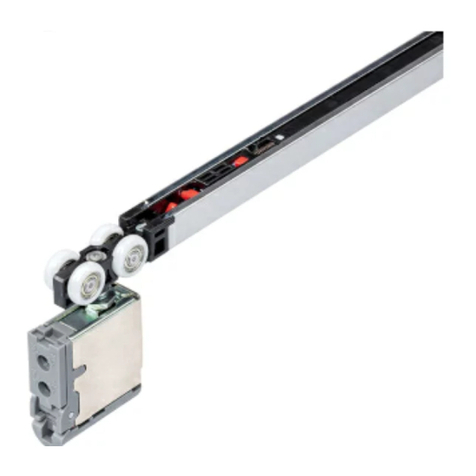
Lamp
Lamp FD25SP installation manual

APRITECH
APRITECH ANTES 24 GUIDE FOR THE INSTALLER
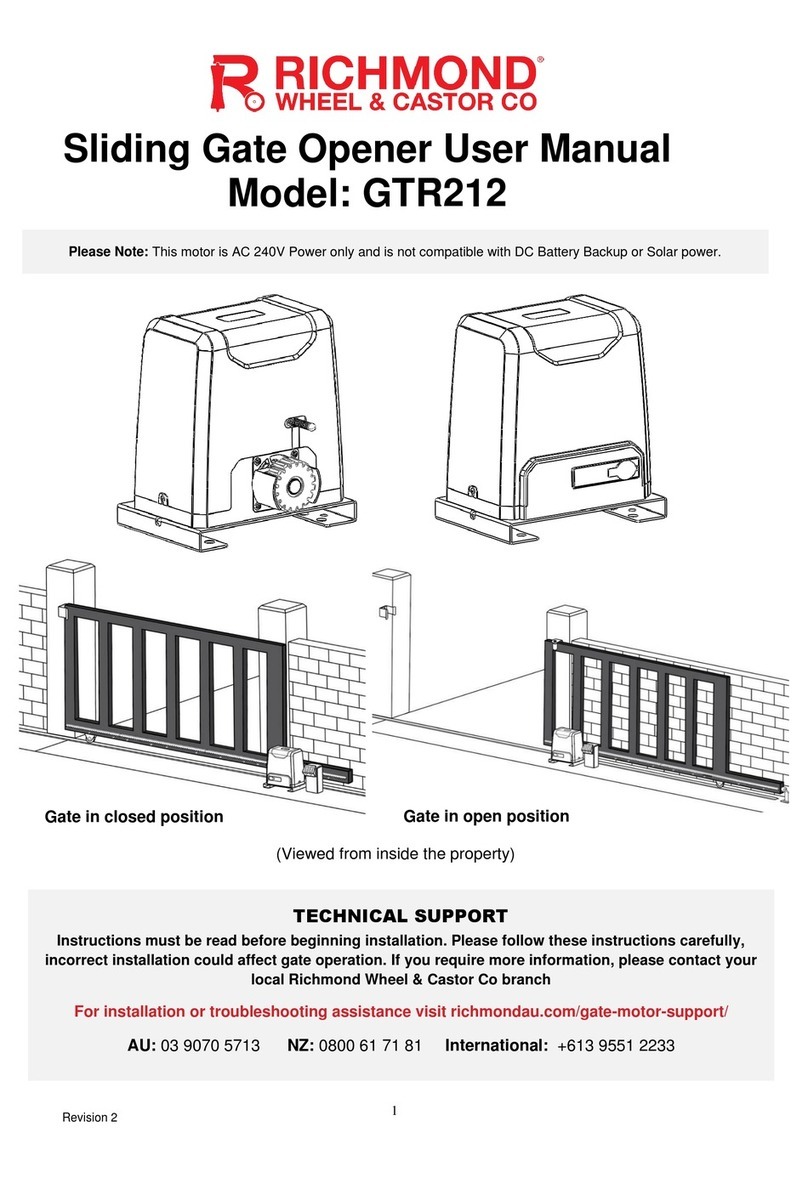
Richmond
Richmond GTR212 user manual
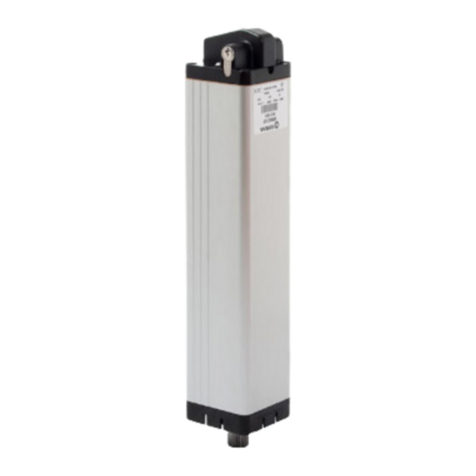
Erreka
Erreka MAGIC Quick installation and programming guide
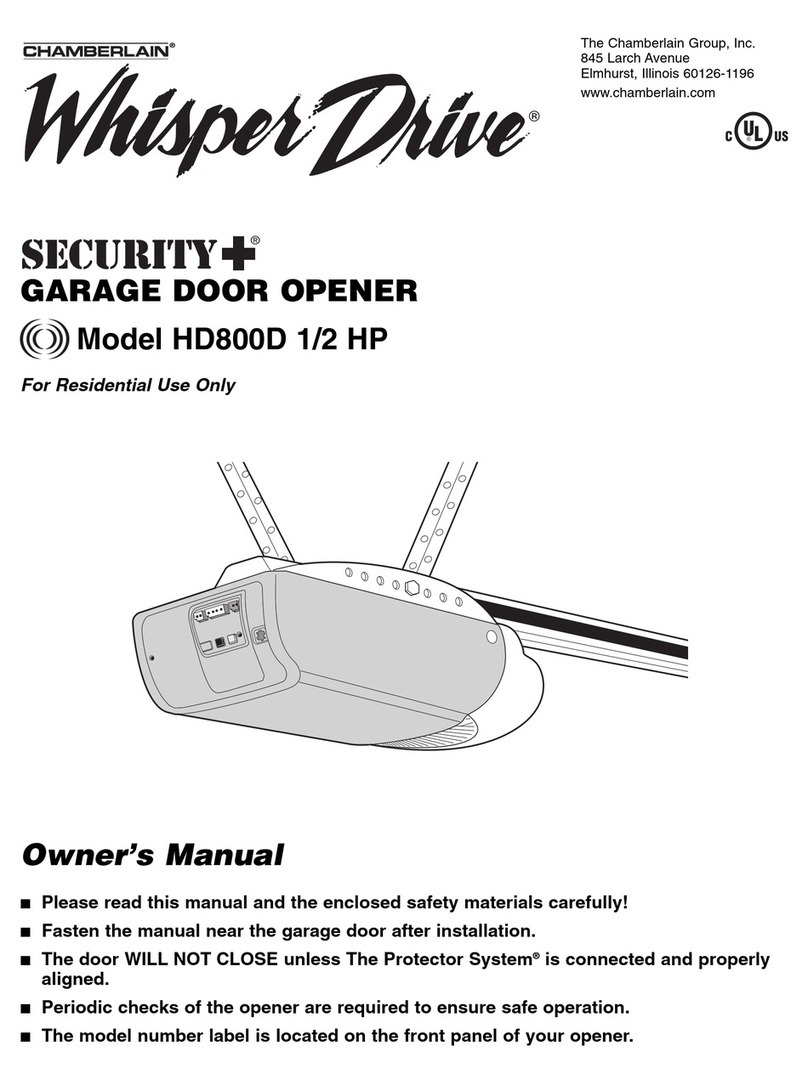
Chamberlain
Chamberlain Whisper Drive Security+ HD800D owner's manual
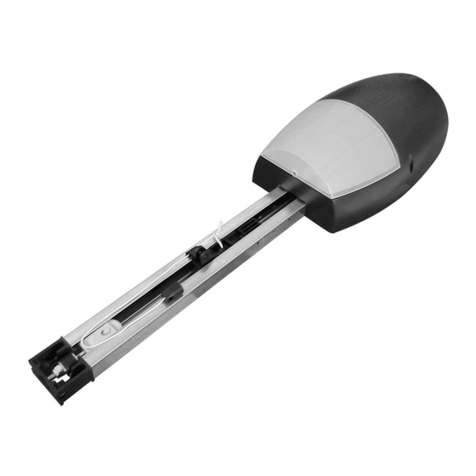
BFT
BFT BOTTICELLI B CRC 480 D01 Installation and user manual

Chamberlain
Chamberlain Security+ 1000SDC-R owner's manual
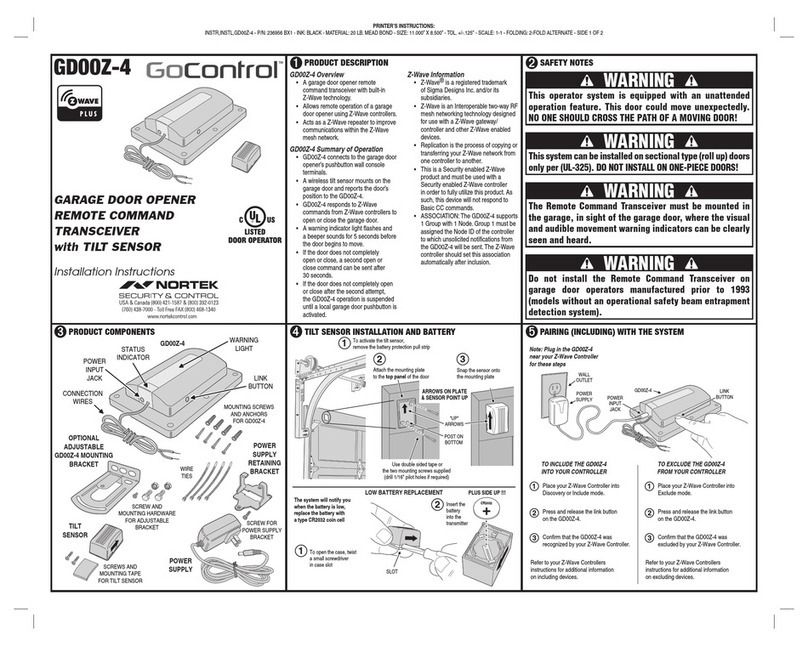
Nortek
Nortek GoControl GD00Z-4 Installation instructions manual
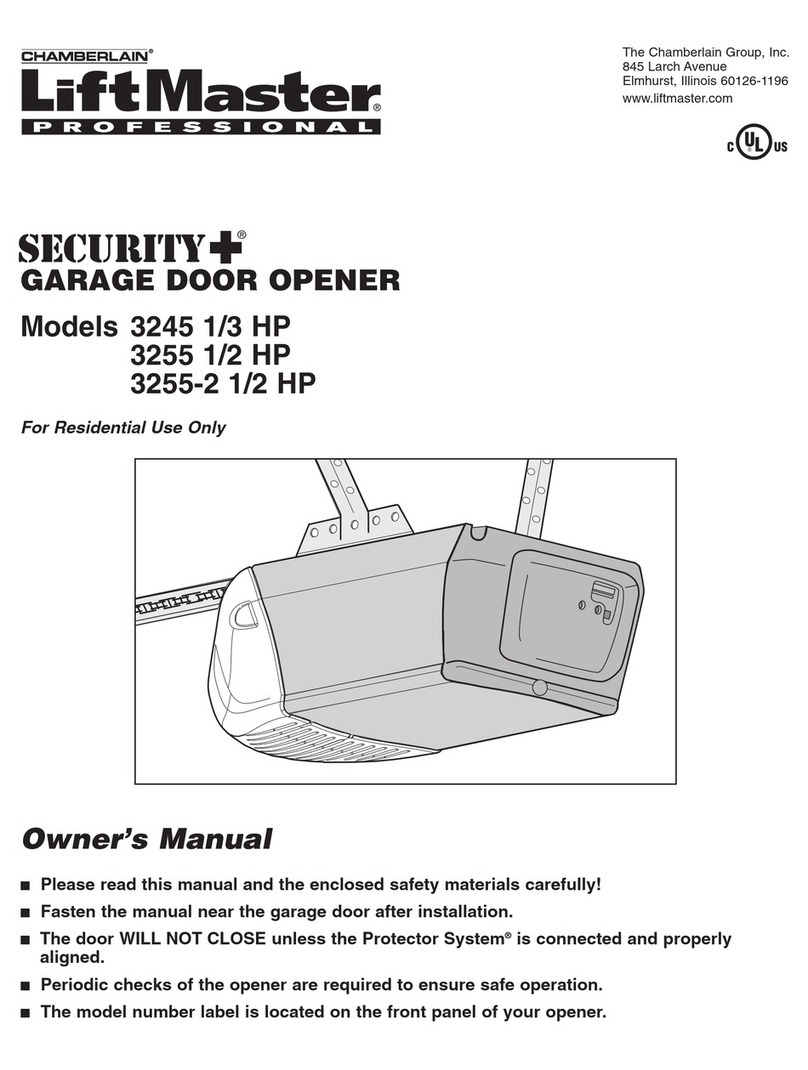
Chamberlain
Chamberlain 3245 1/3 HP owner's manual
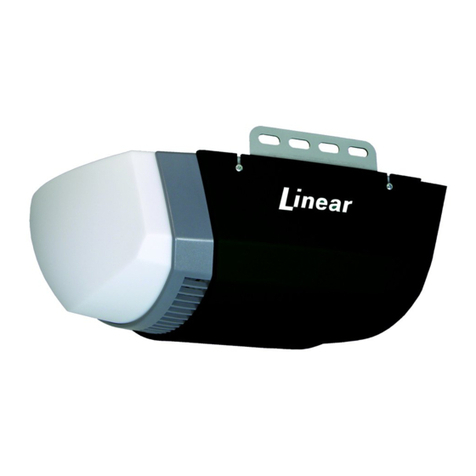
Linear
Linear LDC0801 Homeowner's instructions
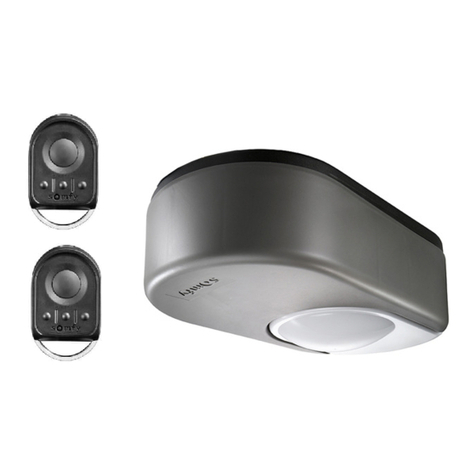
SOMFY
SOMFY Dexxo Pro 800 - 1000 RTS installation manual
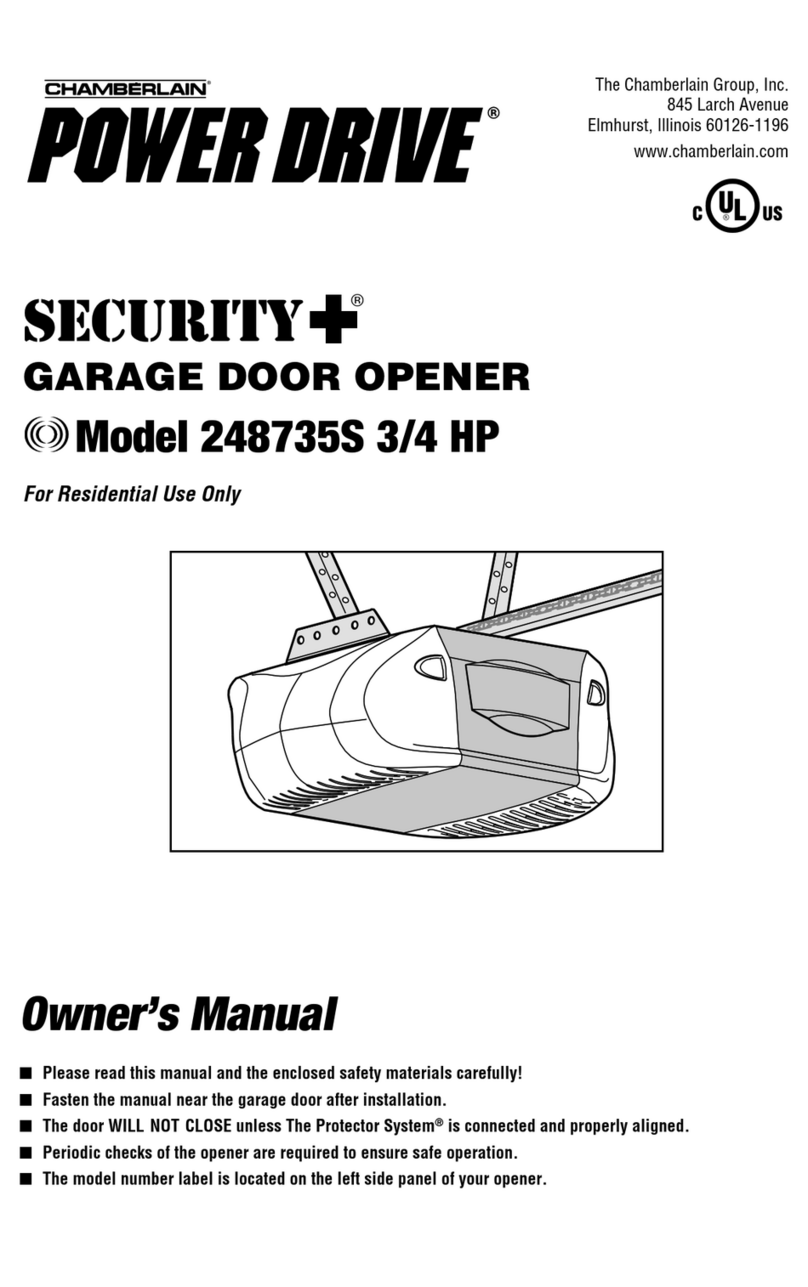
Chamberlain
Chamberlain POWER DRIVE 248735S 3/4 HP owner's manual
